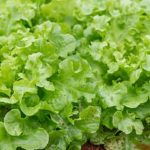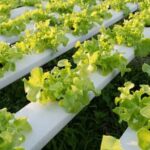Large vegetable gardens offer numerous advantages beyond just providing fresh produce. The expansive size of these gardens allows for a wide variety of vegetables to be grown, providing ample opportunities for experimenting with different crops and growing techniques. Whether you are a seasoned gardener or a beginner looking to delve into large-scale gardening, the benefits of cultivating a sizable vegetable garden are vast.
One key benefit of large vegetable gardens is the ability to grow a substantial amount of fruits and vegetables, potentially reducing grocery bills and promoting self-sufficiency. Additionally, the physical act of tending to a large garden can be therapeutic and rewarding, offering stress relief and a sense of accomplishment. Moreover, the process of planning, designing, and maintaining a large vegetable garden can also help build important skills such as organization, problem-solving, and resource management.
Furthermore, large vegetable gardens can contribute to environmental sustainability by promoting biodiversity, reducing food miles, and minimizing reliance on store-bought produce packaged in plastic. By integrating principles of permaculture and organic gardening practices into your large garden design, you can create an ecosystem that is not only productive but also environmentally friendly.
In the following sections, we will explore various aspects of planning and maintaining a successful large vegetable garden to help you reap the full benefits of this rewarding endeavor.
Planning and Designing Your Large Vegetable Garden
When planning and designing a large vegetable garden, there are several factors to consider to ensure its success. One of the first steps is to choose a suitable location for your garden. Select an area that receives ample sunlight throughout the day and has good drainage to prevent waterlogged soil. Consider the proximity to a water source for irrigation and ease of access for maintenance tasks.
Layout and Design
Next, determine the layout and design of your large vegetable garden. Consider creating raised beds or using traditional rows, depending on the space available and your preference. Plan out pathways between the planting areas to provide easy access for planting, weeding, and harvesting. Additionally, consider incorporating features like trellises for climbing plants or structures for vertical gardening to maximize space.
Companion Planting
Another important aspect of planning your large vegetable garden is companion planting. This practice involves grouping together plants that benefit each other by repelling pests, attracting beneficial insects, or enhancing growth. Research companion planting strategies to create a harmonious environment in your garden and maximize yield.
Sustainability Practices
Lastly, incorporate sustainable practices into the design of your large vegetable garden. Consider implementing techniques like mulching to retain moisture in the soil, composting organic matter to enrich the soil fertility, and rotating crops annually to prevent depletion of nutrients. By incorporating these sustainable practices, you can create a thriving ecosystem in your large vegetable garden that supports healthy plant growth and abundant harvests.
Choosing the Right Vegetables for Your Large Garden
When it comes to planning a large vegetable garden, one of the most crucial aspects is selecting the right vegetables to grow. With ample space at your disposal, you have the freedom to choose a wide variety of crops to cultivate. It is essential to consider factors such as climate, soil conditions, and personal preferences when deciding on the assortment of vegetables for your garden.
One approach to selecting vegetables for a large garden is to include a mix of both common staples and unique varieties. Common vegetables like tomatoes, peppers, zucchinis, and cucumbers are popular choices that are relatively easy to grow and yield abundant harvests. On the other hand, experimenting with unique or heirloom varieties can add diversity and interest to your garden while providing different flavors and textures for your meals.
Moreover, it is advisable to include a combination of fast-growing crops like lettuce and radishes along with long-season plants such as pumpkins or winter squash in your large vegetable garden. This strategic mix allows for continuous harvesting throughout the growing season while also maximizing the use of available space. Additionally, rotating crops each year can help maintain soil fertility and prevent disease build-up in your garden beds.
| Vegetable | Growth Time |
|---|---|
| Tomatoes | 60-85 days |
| Zucchinis | 45-65 days |
| Lettuce | 30-60 days |
By carefully choosing the right vegetables for your large garden based on these considerations, you can create a bountiful and diverse harvest that will not only provide fresh produce for your kitchen but also offer an enjoyable gardening experience. Whether you opt for traditional favorites or exotic varieties, the key is to plan accordingly, sow with intention, and tend with care throughout the growing season in order to reap the rewards of your labor.
Soil Preparation and Maintenance for Large Vegetable Gardens
One of the key factors in having a successful large vegetable garden is proper soil preparation and maintenance. Before planting your crops, it is crucial to test the soil for its pH level and nutrient content.
You can send a sample to your local agricultural extension office for testing or use DIY soil testing kits available at gardening stores. Based on the results, you can then amend the soil with organic matter such as compost, manure, or peat moss to improve its quality.
In addition to initial soil preparation, ongoing maintenance is essential for the health of your large vegetable garden. Regularly adding compost or organic fertilizer throughout the growing season can replenish nutrients in the soil that are absorbed by plants. Rotating your crops each year can also help prevent nutrient depletion and minimize pest and disease issues. Furthermore, mulching around plants can help retain moisture, suppress weeds, and regulate soil temperature.
Effective soil maintenance practices not only improve plant growth and yield but also contribute to sustainable gardening practices. By nurturing healthy soil in your large vegetable garden, you are creating a thriving ecosystem that supports a diverse range of beneficial organisms. With proper care and attention to your garden’s soil, you can enjoy bountiful harvests from your large vegetable garden year after year.
| Key Point | Detail |
|---|---|
| Soil Testing | Test the soil for pH level and nutrient content before planting. |
| Organic Matter | Amend the soil with compost, manure, or peat moss to improve quality. |
| Mulching | Mulch around plants to retain moisture and regulate soil temperature. |
Irrigation Systems for Large Vegetable Gardens
When it comes to maintaining a large vegetable garden, proper irrigation is essential to ensure the health and growth of your plants. Choosing the right irrigation system can make a significant difference in the success of your garden. Here are some common irrigation systems used in large vegetable gardens:
- Drip Irrigation: This system delivers water directly to the roots of plants, minimizing water waste through evaporation. It also helps prevent diseases by keeping foliage dry.
- Sprinkler Systems: Ideal for large garden areas, sprinkler systems deliver water through overhead hoses or pipes. They can be automated for convenience and provide good coverage for a variety of crops.
- Soaker Hoses: These hoses release water along their length, providing slow, consistent watering to the soil around plants. Soaker hoses are ideal for rows of vegetables and can help conserve water.
Proper installation and maintenance of your chosen irrigation system are crucial to ensure efficient water delivery to your plants. Consider factors such as plant spacing, soil type, and weather conditions when designing your irrigation system for a large vegetable garden. Adequate hydration is key to promoting healthy growth and abundant harvests.
In addition to choosing the right irrigation system, monitoring soil moisture levels regularly is important in large vegetable gardens. Invest in tools like moisture meters or simply check the soil by hand to determine when and how much water your plants need. By paying attention to the specific needs of each crop and adjusting your irrigation schedule accordingly, you can optimize growth and productivity in your large vegetable garden.
Pest Control and Disease Prevention in Large Vegetable Gardens
When managing a large vegetable garden, the threat of pests and diseases can be daunting. However, with proper planning and proactive measures, you can minimize the risk of losing your precious crops. Here are some essential tips to help you effectively control pests and prevent diseases in your large vegetable garden:
1. Identify common pests: Familiarize yourself with the typical pests that may target your vegetables. This can include aphids, caterpillars, beetles, and more. By recognizing these pests early on, you can take swift action to address the issue before it escalates.
2. Implement companion planting: Utilize the concept of companion planting to naturally deter pests and enhance disease resilience in your large vegetable garden. Certain plant combinations can repel harmful insects or attract beneficial ones that prey on pests. For example, planting marigolds alongside tomatoes can help protect against nematodes.
3. Practice crop rotation: Rotating your crops each season is crucial for preventing disease buildup in the soil. Different plant families have varying nutrient requirements and vulnerabilities to specific diseases. By rotating your crops, you can disrupt the life cycles of pathogens and reduce the likelihood of infection spreading.
4. Utilize organic pest control methods: Avoid harmful chemical pesticides by opting for organic pest control solutions in your large vegetable garden. This may include introducing beneficial insects like ladybugs or using natural repellents such as neem oil or garlic spray to keep pests at bay.
By incorporating these strategies into your pest control and disease prevention approach, you can maintain a healthy and thriving large vegetable garden throughout the growing season. Stay vigilant, observe your plants regularly, and be prepared to take prompt action when necessary to safeguard your bountiful harvests from potential threats.
Harvesting and Storing Produce From Your Large Vegetable Garden
Having a large vegetable garden can be incredibly rewarding, especially when it comes time to harvest and store the produce you have worked so hard to grow. One of the main benefits of large vegetable gardens is the abundance of fresh, homegrown produce that can be enjoyed throughout the growing season and beyond. Whether you are harvesting crispy cucumbers, juicy tomatoes, or sweet bell peppers, there is nothing quite like picking ripe vegetables straight from your garden.
When it comes to harvesting your vegetables, timing is key. Each type of vegetable has its own specific harvesting window, so it’s important to familiarize yourself with the optimal time to pick each crop. Harvesting too early can result in underdeveloped flavors and textures, while waiting too long can lead to overripe or even spoiled produce. Regularly checking on your plants and monitoring their progress will ensure that you harvest at the perfect time for peak flavor and freshness.
Once you have harvested your bounty, proper storage is essential to make sure that your vegetables last as long as possible. Some vegetables can be stored in a cool, dark place like a root cellar or basement, while others may need to be refrigerated or even frozen for long-term preservation.
Properly storing your harvested produce will help extend its shelf life and allow you to enjoy the fruits of your labor well into the winter months. With careful planning and organization, you can savor the flavors of your large vegetable garden all year round.
Success Stories
Maximizing Space: The Story of the Urban Gardener
One success story that inspires many large vegetable gardeners is that of an urban gardener who was able to maximize limited space to create a bountiful harvest. Despite living in a small apartment with only a balcony for outdoor space, this gardener used vertical gardening techniques to grow an impressive variety of vegetables.
By utilizing hanging baskets, trellises, and wall-mounted planters, they were able to cultivate a diverse range of crops such as tomatoes, cucumbers, peppers, and herbs. This story serves as a reminder that even those with minimal space can still enjoy the benefits of a large vegetable garden.
Community Collaboration: The Power of Shared Gardens
Another inspiring success story comes from a group of neighbors who came together to create a shared large vegetable garden in their community. By pooling resources, labor, and expertise, these gardeners were able to transform an unused plot of land into a thriving oasis of fresh produce.
Each member contributed their unique skills – from planting and watering to weeding and harvesting – resulting in a bountiful harvest that benefitted the entire neighborhood. This story highlights the power of collaboration and demonstrates how working together can lead to incredible results in large vegetable gardens.
Sustainable Farming Practices: Lessons From Eco-Conscious Gardeners
Some experienced large vegetable gardeners are leading the way in sustainable farming practices by incorporating eco-friendly methods into their gardening routines. From using organic fertilizers and compost to practicing crop rotation and companion planting, these gardeners prioritize soil health and biodiversity in their gardens.
By adopting environmentally conscious techniques, they not only produce healthy and nutritious crops but also contribute to the overall well-being of the ecosystem. Their success stories serve as valuable lessons for other large vegetable gardeners looking to cultivate thriving gardens while minimizing their environmental impact.
Tips for Beginners to Start Their Own Large Vegetable Garden
Large vegetable gardens offer a plethora of benefits to individuals and communities alike. Not only do they provide a sustainable source of fresh produce, but they also promote healthy eating habits, environmental conservation, and a sense of satisfaction and accomplishment. By cultivating a large vegetable garden, individuals have the opportunity to connect with nature, reduce their carbon footprint, and enjoy the fruits of their labor.
When starting your own large vegetable garden as a beginner, it is essential to take the time to plan and design your garden effectively. Consider factors such as sunlight exposure, soil quality, water availability, and space constraints before selecting which vegetables to grow. By carefully planning the layout of your garden and choosing the right vegetables based on your climate and preferences, you can set yourself up for success in producing a bountiful harvest.
In addition to proper planning and design, soil preparation and maintenance are key elements in the success of large vegetable gardens. Testing your soil for nutrient levels and pH balance can help you determine which amendments are needed to create optimal growing conditions for your crops.
Regularly tending to your garden by weeding, mulching, and rotating crops will help maintain soil fertility and prevent disease outbreaks. With dedication and hard work, beginners can achieve thriving large vegetable gardens that yield an abundance of fresh produce year after year.
Frequently Asked Questions
How Do You Layout a Large Vegetable Garden?
When laying out a large vegetable garden, it is essential to consider factors such as sunlight exposure, water availability, and soil quality. Start by designating specific areas for different types of vegetables based on their sunlight requirements and growth habits.
Make sure to leave enough space between rows for easy access and proper airflow. Additionally, creating paths or walkways will help with maintenance and harvesting tasks.
How Do You Grow a Large Vegetable Garden?
Growing a large vegetable garden requires careful planning and consistent maintenance. Begin by preparing the soil through testing and amending as needed to provide essential nutrients for plant growth.
Choose a variety of vegetables that thrive in your climate zone and ensure proper spacing between plants to prevent overcrowding. Regular watering, weeding, and fertilizing are crucial to support healthy plant development throughout the growing season.
What Is a Good Size Vegetable Garden?
The ideal size for a vegetable garden depends on individual preferences, available space, and gardening goals. A good starting point is around 100 square feet, which can yield a substantial amount of produce for a family of four while still being manageable to maintain.
However, the size can vary based on factors such as the number of people being fed, culinary preferences, and time commitment available for gardening. It’s important to start small and expand gradually as you gain more experience and confidence in vegetable gardening.

If you’re looking to get into vegetable gardening, or are just looking for some tips on how to make your current garden better, then you’ve come to the right place! My name is Ethel and I have been gardening for years. In this blog, I’m going to share with you some of my best tips on how to create a successful vegetable garden.





